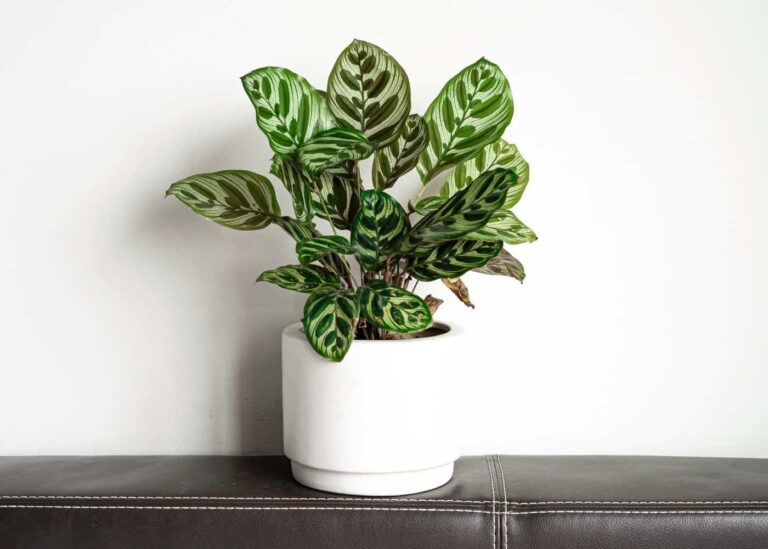Here we have the Peacock Plant, or Calathea Makoyana, a member of the Calathea genus and a highly sought-after tropical houseplant.
Its common name is derived from the vivid patterns adorning its broad leaves, which bear a striking resemblance to the elegant plumage of the peacock (and to the prayer plant). The foliage is a stunning display of natural art, displaying a diverse range of hues, including verdant greens, creamy whites, delicate pinks, and moody grays, all set against a backdrop of deep, reddish-maroon stems.
Similarly to the Elephant Ears, Peacock plants thrives in warm, humid environments and should be kept out of direct sunlight, making it a formidable challenge for those new to the world of houseplants.
Care
This plant requires specific care to thrive, making it a challenging species for novice houseplant collectors. However, if given the right conditions, these plants will display stunning lush foliage. These are the most important things to keep in mind:
- Light: It is important to provide filtered light to avoid intense, direct sunlight that can fade the patterns and colors on the leaves.
- Soil: The ideal soil for these plants should retain moisture while still being well-drained, with high levels of organic matter to ensure vibrant leaf production and color.
- Water: To avoid underwatering or root rot, peacock plants need consistent and even levels of moisture, with distilled or rainwater recommended over tap water.
- Temperatures: Temperatures between 60ºF – 75ºF and high humidity levels are crucial for these plants, with misting and humidifiers recommended to achieve the ideal environment.
Propagation
One of the best ways to propagate Peacock Plants is through division. Now, this process can be quite challenging, so it’s best to wait until the plant has formed a substantial and well-established clump.
Once you have identified a suitable clump, carefully remove it from its pot and divide it into smaller sections, ensuring that each division has an adequate number of leaves and roots. These repotted divisions must then be kept moist, warm, and humid while they establish.
If you’re worried about the humidity levels in your environment, you can cover the newly potted plants with polythene sheeting to create a more humid microclimate around the plants.
Common Pests
Pruning
No need to worry about pruning your peacock plant for growth control because they tend to grow at a slow pace. Eventually, the older leaves will turn brown, especially if the calathea gets too hot or dry.
If you notice brown tips on the leaves, simply grab a pair of sterilized garden pruners or scissors. You can trim off the brown tip or, if the entire leaf has changed color, cut the stem near the soil line to remove the whole leaf and its stem. It’s an easy way to keep your plant looking fresh and healthy!
Frequently Asked Questions
To ensure that your Peacock Plant thrives, you’ll need to provide it with adequate moisture, but avoid overwatering that could lead to waterlogged soil. Striking a delicate balance is key. It’s recommended to use rainwater, filtered or bottled water at room temperature for irrigation, as this plant is sensitive to hard water.
Also, it is important to provide filtered light to avoid intense, direct sunlight that can fade the patterns and colors on the leaves.
Does a peacock plant purify air?
Peacock plant not only adds a pop of color and texture to your home, but it can also improve the air quality. This plant has been shown to be effective at removing common toxins from the air, making it a great choice for those looking for a natural way to improve indoor air quality.
Do peacock plants need sunlight?
Like every plant, Peacock plants also require a sufficient amount of sunlight to thrive. But in this case, the light should be filtered to avoid intense, direct sunlight.
Should I mist my peacock plant?
A peacock plant can benefit from misting to provide it with sufficient humidity. Look out for brown tips and edges on leaves, which may be a result of dry air. Putting it on a tray of damp pebbles, gravel or clay pellets is a good idea, too.

